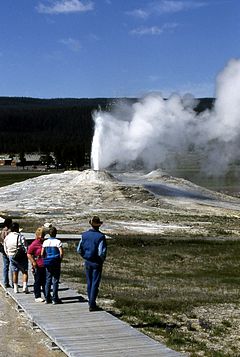Lion Geyser
In today's article we are going to delve into the topic of Lion Geyser, a topic that has aroused great interest in recent years. Lion Geyser is an area of study that has captured the attention of academics, experts and enthusiasts alike, and has generated debate and research in various fields. From its impact on society to its implications in everyday life, Lion Geyser has proven to be a relevant and constantly evolving topic. In this article, we will explore different aspects and perspectives of Lion Geyser, in order to shed light on this fascinating topic and provide a more complete view of its importance in today's world.
| Lion Geyser | |
|---|---|
 Eruption, 1987 | |
 | |
| Location | Upper Geyser Basin, Yellowstone National Park, Teton County, Wyoming |
| Coordinates | 44°27′50″N 110°49′51″W / 44.4640243°N 110.8309603°W |
| Elevation | 7,405 feet (2,257 m) |
| Type | Cone geyser |
| Eruption height | 90 feet (27 m) |
| Duration | 7 minutes |
| Temperature | 92.1 °C (197.8 °F) |
Lion Geyser is a cone-type geyser in the Upper Geyser Basin of Yellowstone National Park in the United States. It is located in the Geyser Hill complex.
It was named for the roaring sound of steam releasing during an eruption. Eruptions can reach 90 feet (27 m) and last from 1 to 7 minutes. Lion is the largest of the Lion Group which includes Little Cub Geyser and the currently inactive Big Cub and Lioness geysers.
Images of Lion Geyser
References
- ^ a b "Lion Geyser". Yellowstone Geothermal Features Database. Montana State University.
- ^ "Lion Geyser". Geographic Names Information System. United States Geological Survey, United States Department of the Interior.
- ^ "Geyser Hill". Geyser Observation and Study Association. Archived from the original on 2010-11-29. Retrieved 2010-11-11.
- ^ "Lion Geyser". Geyser Observation and Study Association.
- ^ "Lion Group of Geysers". National Park Service.


